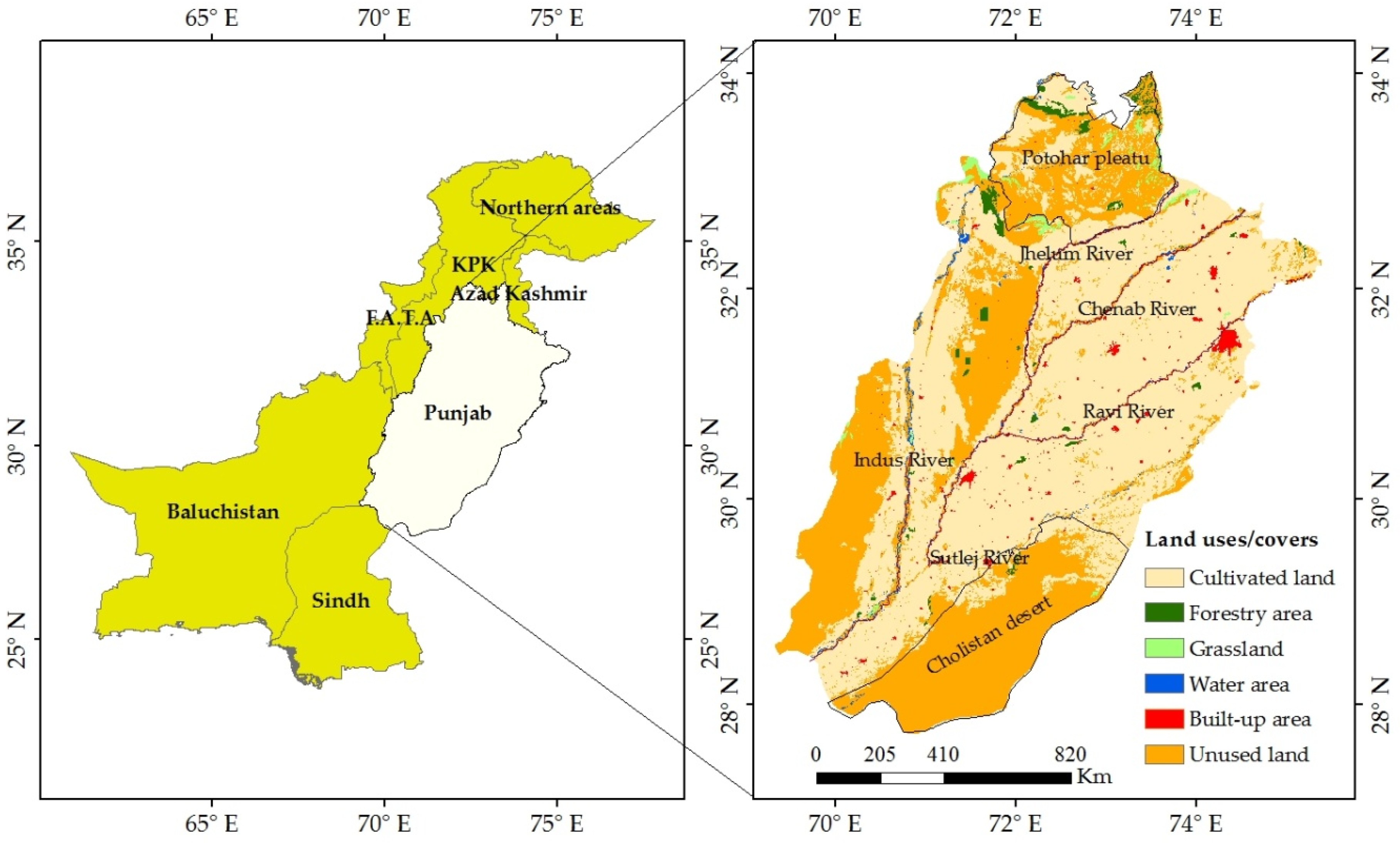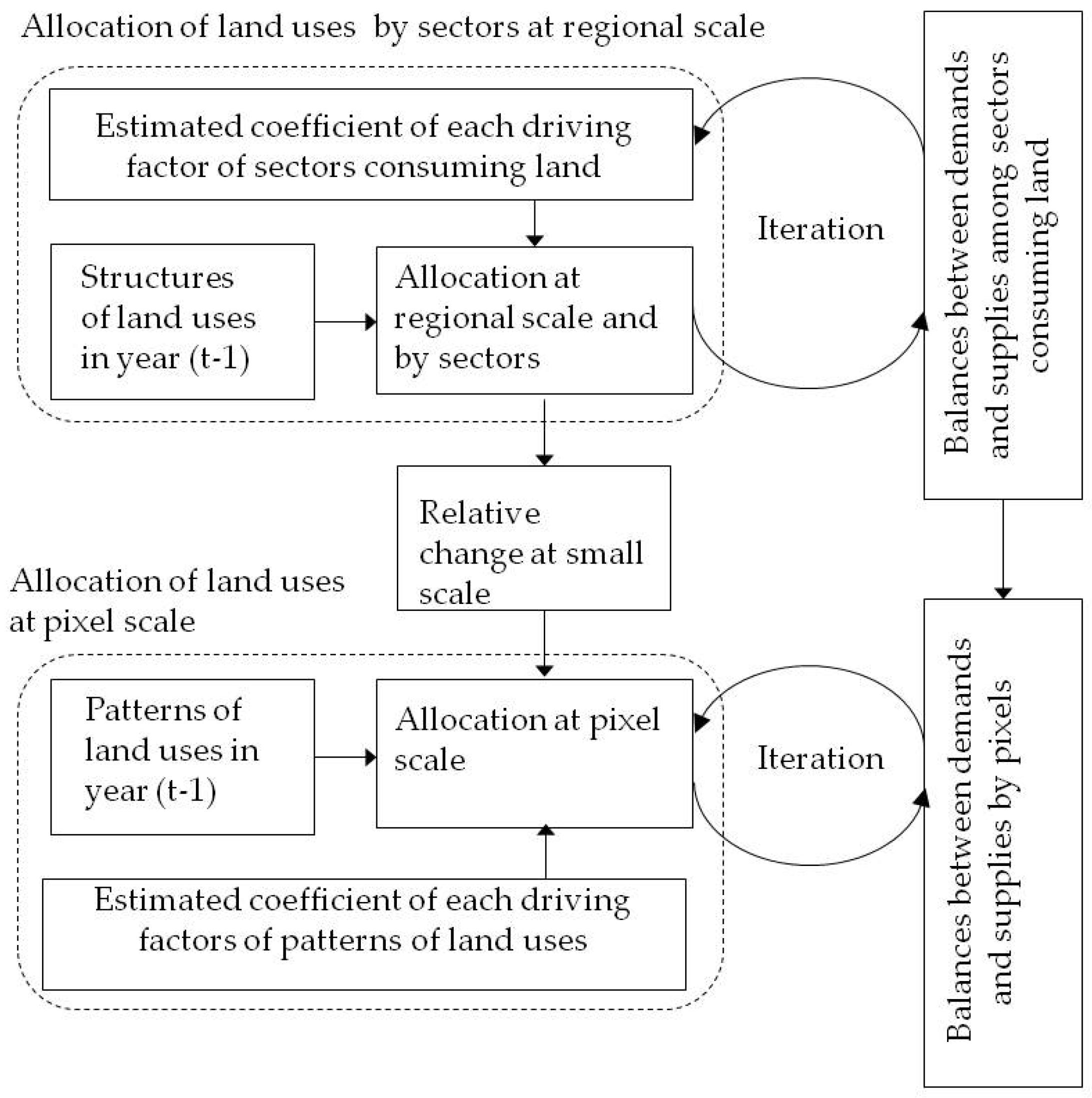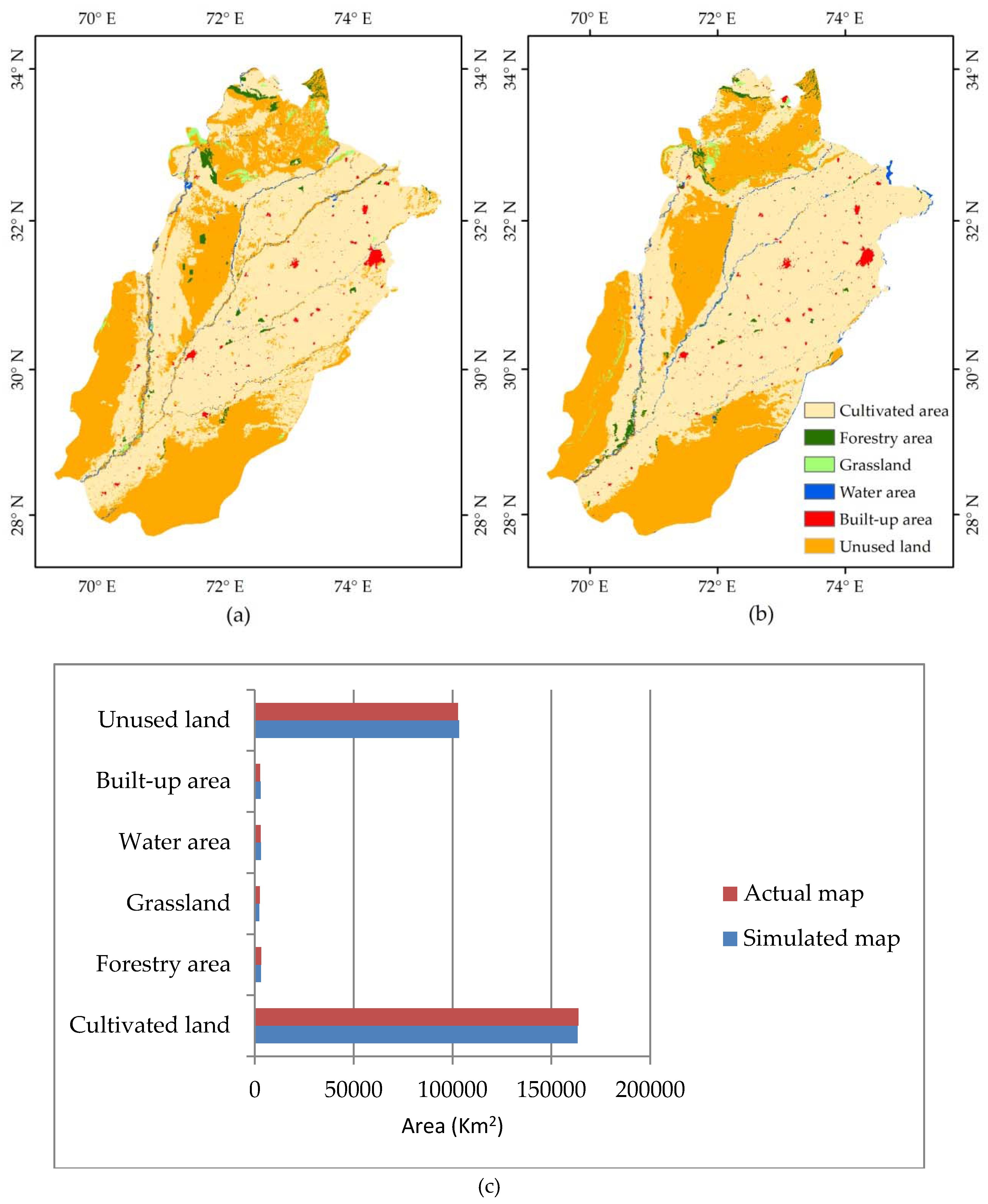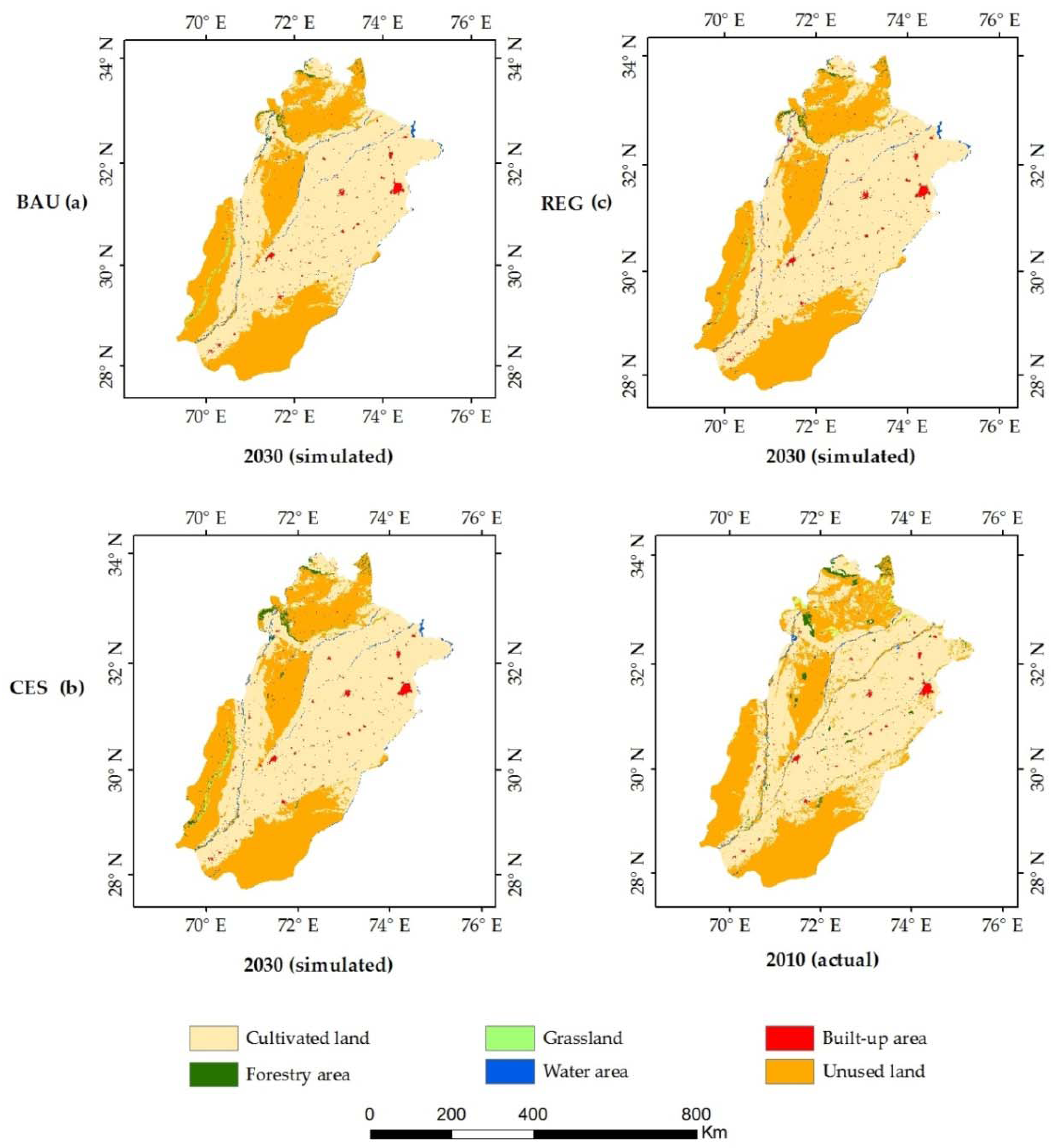Scenario-Based Simulation on Dynamics of Land-Use-Land-Cover Change in Punjab Province, Pakistan
Abstract
:1. Introduction
2. Data and Methodology
2.1. Study Area
2.2. Data
2.2.1. Land Use Data
2.2.2. Data on Various Influencing Factors of Land Use Changes in Punjab Province
2.3. Methodology
2.3.1. Spatial Allocation of Land Use Area Changes
2.3.2. Scenario Development
Business-As-Usual (BAU) Scenario
Coordinated Environmental Sustainability (CES) Scenario
Rapid Economic Growth (REG) Scenario
2.3.3. The Dynamics of Land System (DLS) Model
2.3.4. Validation of the DLS Model
3. Results
3.1. Performance of DLS Model
3.2. Analysis of Influencing Factors for Dynamics of Land Use Changes
3.3. Simulation of Land Use Changes
4. Discussion
5. Conclusions
Acknowledgments
Author Contributions
Conflicts of Interest
References
- Lambin, E.F.; Geist, H.J.; Lepers, E. Dynamics of land-use and land-cover change in tropical regions. Annu. Rev. Environ. Resour. 2013, 28, 205–241. [Google Scholar] [CrossRef]
- Lambin, E.F.; Meyfroidt, P. Global land use change, economic globalization, and the looming land scarcity. Proc. Natl. Acad. Sci. USA 2011, 108, 3465–3472. [Google Scholar] [CrossRef] [PubMed]
- Sagan, C.; Toon, O.B.; Pollack, J.B. Anthropogenic albedo changes and the earth’s climate. Science 1979, 206, 1363–1368. [Google Scholar] [CrossRef] [PubMed]
- Trimble, S.W.; Crosson, P. Land use—US soil erosion rates: myth and reality. Science 2000, 289, 248–250. [Google Scholar] [CrossRef] [PubMed]
- Sala, O.E.; Chapin, F.S.; Armesto, J.J.; Berlow, E.; Bloomfield, J. Global biodiversity scenarios for the year 2100. Science 2000, 287, 1770–1774. [Google Scholar] [CrossRef] [PubMed]
- Vitousek, P.M.; Mooney, H.A.; Lubchenco, J.; Melillo, J.M. Human domination of earth’s ecosystems. Science 1997, 277, 494–499. [Google Scholar] [CrossRef]
- Turner II, B.L. Local faces, global flows: The role of land use and land cover in global environmental change. Land Degrad. Rehabil. 1994, 5, 71–78. [Google Scholar] [CrossRef]
- Verburg, P.H.; Soepboer, W.V.A.; Limpiada, R.V.A.; Espaldon, V. Modeling the spatial dynamics of regional land use: The CLUE-S model. Environ. Manag. 2002, 30, 391–405. [Google Scholar] [CrossRef] [PubMed]
- Verburg, P.H.; Erb, K.-H.; Mertz, O.; Espindola, G. Land System Science: Between global challenges and local realities. Curr. Opin. Environ. Sustain. 2013, 5, 433–437. [Google Scholar] [CrossRef] [PubMed]
- Verburg, P.H.; Overmars, K.P. Dynamic simulation of land-use change trajectories with the CLUE-S model. In Modelling Land-Use Change; Koomen, E., Stillwell, J., Bakema, A., Scholten, H.J., Eds.; Springer: Amsterdam, The Netherlands, 2007; Volume 90, pp. 321–337. [Google Scholar]
- Rao, K.S.; Pant, R. Land use dynamics and landscape change pattern in a typical micro watershed in the mid elevation zone of central Himalaya, India. Agric. Ecosyst. Environ. 2001, 86, 113–124. [Google Scholar] [CrossRef]
- Semwal, R.L.; Nautiyal, S.; Sen, K.K.; Rana, U.; Maikhuri, R.K.; Rao, K.S.; Saxena, K.G. Patterns and ecological implications of agricultural land-use changes: A case study from central Himalaya, India. Agric. Ecosyst. Environ. 2004, 102, 81–92. [Google Scholar] [CrossRef]
- Braimoh, A.K.; Onishi, T. Spatial determinants of urban land use change in Lagos, Nigeria. Land Use Policy 2007, 24, 502–515. [Google Scholar] [CrossRef]
- Liu, J.; Liu, M.; Zhuang, D. Analysis of China’s recent change of land use spatial pattern. Sci. China Earth Sci. 2002, 32, 1031–1040. (In Chinese) [Google Scholar]
- Couclelis, H. Where has the future gone? Rethinking the role of integrated land-use models in spatial planning. Environ. Plan. 2005, 37, 1353–1371. [Google Scholar] [CrossRef]
- Li, P.; Li, X.; Liu, X. Macro-analysis on the driving forces of the land-use change in China. Geogr. Res. 2001, 20, 129–138. (In Chinese) [Google Scholar]
- Britz, W.; Verburg, P.H.; Leip, A. Modeling of land cover and agricultural change in Europe: Combining the CLUE and CAPRI-Spat approaches. Agric. Ecosyst. Environ. 2011, 142, 40–50. [Google Scholar] [CrossRef]
- Deng, H.; He, Z.; Chen, Y. The land use spatio-temporal pattern simulation in metropolitan fringe of the Sichuan Basin: A case study in Yanjian District, Ziyang City, Sichuan. Sci. Geogr. Sin. 2013, 33, 1524–1530. (In Chinese) [Google Scholar]
- Evans, T.P.; Manire, A.; de Castro, F.E.A. A dynamic model of household decision-making and parcel level land cover change in the eastern Amazon. Ecol. Model. 2001, 143, 95–113. [Google Scholar] [CrossRef]
- Tang, H.; Wu, W.; Yang, P.E.A. Recent progresses of land use and land cover change (LUCC) models. Acta Geogr. Sin. 2009, 64, 457–468. (In Chinese) [Google Scholar]
- Zhang, W.; Liu, M.; Qi, Y. Land-use scenarios simulation based on the CLUE-S model in Kunming. Chin. J. Ecol. 2014, 33, 1655–1662. (In Chinese) [Google Scholar]
- Hu, R.; Dong, S. Land use dynamics and landscape patterns in Shanghai, Jiangsu and Zhejiang. J. Res. Ecol. 2013, 4, 141–148. (In Chinese) [Google Scholar]
- Ligtenberg, A.; Bregt, A.K.; Lammeren, R.V. Multi-actor-based land use modeling: Spatial planning using agents. Landsc. Urban Plan. 2001, 56, 21–33. [Google Scholar] [CrossRef]
- Bah, A.; Toure, I.; Le Page, C.; Ickowicz, A.; Diop, A.T. An agent-based model to understand the multiple uses of land and resources around drillings in Sahel. Math. Comput. Model. 2006, 44, 513–534. [Google Scholar] [CrossRef]
- Hu, Y.; Zheng, Y.; Zheng, X. Simulation of land-use scenarios for Beijing using CLUE-S and Markov composite models. Chin. Geogr. Sci. 2013, 23, 92–100. [Google Scholar] [CrossRef]
- Xia, L.; Gar-On Yeh, A. Neural-network-based cellular automata for simulating multiple land use changes using GIS. Int. J. Geogr. Inf. Sci. 2002, 16, 323–343. [Google Scholar]
- Nazir, N.; Olabisi, L.S. Forest Area and Land Use Change in Pakistan: A System Dynamics Approach. 2015. Available online: http://www.systemdynamics.org/conferences/2015/proceed/papers/P1296.pdf (accessed on 16 March 2016).
- Deng, X.Z.; Su, H.B.; Zhan, J.Y. Integration of multiple data sources to simulate the dynamics of land systems. Sensors 2008, 8, 620–634. [Google Scholar] [CrossRef] [PubMed]
- Deng, X.; Jiang, Q.; Zhan, J.; He, S.; Lin, Y. Simulation on the dynamics of forest area changes in Northeast China. J. Geogr. Sci. 2010, 20, 495–509. [Google Scholar] [CrossRef]
- Deng, X. Modeling Framework. In Modeling the Dynamics and Consequences of Land System Change; Springer: Berlin/Heidelberg, Germany, 2011; pp. 41–89. [Google Scholar]
- Zhen, L.; Deng, X.; Wei, Y.; Jiang, Q.; Lin, Y.; Helming, K.; Wang, C.; König, H.; Hu, J. Future land use and food security scenarios for the Guyuan district of remote western China. iForest 2014, 7, 372–384. [Google Scholar] [CrossRef]
- Hasan, S.; Deng, X.; Li, Z.; Chen, D. Projections of Future Land Use in Bangladesh under the Background of Baseline, Ecological Protection and Economic Development. Sustainability 2017, 9, 505. [Google Scholar] [CrossRef]
- Chen, D.; Deng, X.; Jin, G.; Samie, A.; Li, Z. Land-use-change induced dynamics of carbon stocks of the terrestrial ecosystem in Pakistan. Phys. Chem. Earth 2017, in press. [Google Scholar] [CrossRef]
- Ke, X.; Ma, E.; Yuan, Y. Scenario Simulation of the Influence of Land Use Change on the Regional Temperature in a Rapidly Urbanizing Region: A Case Study in Southern-Jiangsu, China. Adv. Meteorol. 2014, 2014, 1–12. [Google Scholar] [CrossRef]
- Li, Z.; Deng, X.; Wu, F.; Hasan, S. Scenario Analysis for Water Resources in Response to Land Use Change in the Middle and Upper Reaches of the Heihe River Basin. Sustainability 2015, 7, 3086–3108. [Google Scholar] [CrossRef]
- CDPR. Urban Development in Punjab: A Political Economy Analysis; Consortium for Development Policy Research: Lahore, Pakistan, 2011. [Google Scholar]
- FAO. Agricultural Sector in Pakistan. 1998. Available online: http://www.pakissan.com/english/agri.overview/fao.agricultural.sector.pakistan1.shtml (accessed on 27 April 2016).
- Ahmad, M. Agricultural Productivity Growth Differential in Punjab, Pakistan: A District-level Analysis. Pak. Dev. Rev. 2001, 40, 1–25. [Google Scholar]
- Khan, M.A.; Ahmad, M.; Hashmi, H.S. Review of Available Knowledge on Land Degradation in Pakistan. 2012. Available online: http://pdf.usaid.gov/pdf_docs/PBAAF673.pdf (accessed on 9 December 2014).
- Zaman, K.-U. Urbanization of arable land in Lahore city in Pakistan. A case-study. Eur. J. Sustain. Dev. 2012, 1, 69–83. [Google Scholar]
- Government of Punjab. Punjab Forestry Sector. Forest Policy Statement. (Forests, Watershed, Rangelands and Wildlife). 1999. Available online: http://fwf.punjab.gov.pk/sites/fwf.punjab.gov.pk/files/Forest%20Policy.pdf (accessed on 3 March 2011).
- WWF. WWF-Pakistan Expresses Grave Concern on the Recent Punjab Forest Act amendment. Available online: http://www.wwfpak.org/newsroom/240216_forest.php#sthash.Mkt7GGSZ.dpuf (accessed on 24 February 2016).
- Ali, G.; Nitivattananon, V. Exercising multidisciplinary approach to assess interrelationship between energy use, carbon emission and land use change in a metropolitan city of Pakistan. Renew. Sustain. Energy Rev. 2012, 16, 775–786. [Google Scholar] [CrossRef]
- Government of Punjab. Punjab Growth Strategy 2018: Accelerating Economic Growth and Improving Social Outcomes. 2015. Available online: http://www.pndpunjab.gov.pk/system/files/Punjab_Growth_Strategy_2018_0.pdf (accessed on 31 March 2015).
- Haq, R.; Farooq, N. Impact of CPEC on Social Welfare in Pakistan: A District Level Analysis. In Proceedings of the 32nd Annual General Meeting and Conference, Pakistan Society of Development Economics, Pakistan Institute of Development Economics, Islamabad, Pakistan, 13–15 December 2016. [Google Scholar]
- Bhatti, S.S.; Tripathi, N.K.; Nitivattananon, V.; Rana, I.A.; Mozumder, C. A multi-scale modeling approach for simulating urbanization in a metropolitan region. Habitat Int. 2015, 50, 354–365. [Google Scholar] [CrossRef]
- Bhalli, M.N.; Ghaffar, A.; Shirazi, S.A.; Parveen, N. Use of multi-temporal digital data to monitor LULC changes in Faisalabad-Pakistan. Pak. J. Sci. 2013, 65, 58–62. [Google Scholar]
- Mehmood, H.; Sajjad, S.H.; Shirazi, S.A. Spatio-temporal trends and patterns of urban sprawl in Gujranwala city, Punjab-Pakistan. Pak. J. Sci. 2017, 69, 63–68. [Google Scholar]
- Ali, S.S. Changing Spatial Patterns of Agriculture in the Punjab Province and the Food Sustainability. J. Basic Appl. Sci. 2013, 9, 389–400. [Google Scholar] [CrossRef]
- Burki, S.J. Punjab’s Economic Importance. Available online: https://tribune.com.pk/story/378252/Punjabs -economic-importance/ (accessed on 13 May 2012).
- Dowall, D.; Ellis, P. Urban Land and Housing Markets in the Punjab, Pakistan. Available online: https://openknowledge.worldbank.org/handle/10986/8280 (accessed on 15 June 2006).
- Hijmans, R.; Cameron, S.E.; Parra, J.L.; Jones, P.G.; Jarvis, A. Very high resolution interpolated climate surfaces for global land areas. Int. J. Climatol. 2005, 25, 1965–1978. [Google Scholar]
- Shirazi, S. Spatial analysis of NDVI and density of population: A case study of Lahore-Pakistan. Sci. Int. 2012, 24, 323–328. [Google Scholar]
- FAO. Asia-Pacific Forestry Sector Outlook Study II: Pakistan Forestry Outlook Study. Working Paper No. APFSOS II/WP/2009/28. Available online: http://www.fao.org/docrep/014/am623e/am623e00.pdf (accessed on 16 January 2016).
- Shehzad, K.; Qamer, F.M.; Murthy, M.; Abbas, S.; Bhatta, L.D. Deforestation Trends and Spatial Modelling of its Drivers in the Dry Temperate Forests of Northern Pakistan—A Case Study of Chitra. J. Mt. Sci. 2014, 11, 1192–1207. [Google Scholar] [CrossRef]
- Butt, A.; Shabbir, R.; Ahmad, S.S.; Aziz, N.; Nawaz, M.; Shah, M.T.A. Land cover classification and change detection analysis of rawal watershed using remote sensing data. J. Biodivers. Environ. Sci. 2015, 6, 236–248. [Google Scholar]
- Abbas, A.; Amjath-Babu, T.S.; Kächele, H.; Usman, M.; Müller, K. An overview of flood mitigation strategy and research support in South Asia: Implications for sustainable flood risk management. Int. J. Sustain. Dev. World Ecol. 2016, 23, 98–111. [Google Scholar] [CrossRef]
- Usman, M.; Abbas, A.; Saqib, Z.A. Conjunctive use of water and its management for enhanced productivity of major crops across tertiary canal irrigation system of Indus basin in Pakistan. Pak. J. Agric. Sci. 2016, 53, 257–264. [Google Scholar] [CrossRef]
- FAO. The Land Cover Atlas of Pakistan: The Punjab Province. Available online: http://www.glcn.org/activities/pak_lc_en.jsp (accessed on 28 September 2015).
- Jiang, Q.; Cheng, Y.; Jin, Q.; Deng, X.; Qi, Y. Simulation of Forestland Dynamics in a Typical Deforestation and Afforestation Area under Climate Scenarios. Energies 2015, 8, 10558–10583. [Google Scholar] [CrossRef]
- DIVA-GIS. Elevation, roads. Available online: http://www.diva-gis.org/gdata (accessed on 10 October 2016).
- ISRIC: World Soil Information. Available online: https://www.soilgrids.org/#!/?layer=PHIHOX_M_sl2_250m (accessed on 11 October 2016).
- WorldPop. High resolution age-structured population distribution maps. Available online: http://www.worldpop.org.uk/data/get_data/ (accessed on 1 November 2016).
- Doll, C.N.H.; Muller, J.P.; Morley, J.G. Mapping regional economic activity from night-time light satellite imagery. Ecol. Econ. 2006, 57, 75–92. [Google Scholar] [CrossRef]
- EIU Canback. Available online: https://www.canback.com/c-gidd/ (accessed on 5 November 2016).
- Eric, P.J.; Beurs, K.M.B.; Hartkamp, A.D. Kriging and thin plate splines for mapping climate variables. Int. J. Appl. Earth Obs. Geoinform. 2001, 3, 146–154. [Google Scholar]
- Batjes, N.H.; Ribeiro, E.; van Oostrum, A.; Leenaars, J.; Hengl, T.; de Mendes, J.J. WoSIS Serving standardised soil profile data for the world. Earth Systain. Sci. Data Discuss. 2016, 9, 1–14. [Google Scholar] [CrossRef]
- Ribeiro, E.; Batjes, N.H.; Leenaars, J.G.B.; Van Oostrum, A.J.M.; de Mendes, J.J. Towards the Standardization and Harmonization of World Soil Data; Procedures Manual ISRIC World Soil Information Service (WoSIS Version 2.0); ISRIC—World Soil Information: Wageningen, The Netherlands, 2015; p. 110. Available online: http://www.isric.org/sites/default/files/isric_report_2015_03.pdf (accessed on 1 April 2015).
- Aguiar, A.P.D.; Camara, G.; Escada, M.I.S. Spatial statistical analysis of land-use determinants in the Brazilian Amazonia: Exploring intra-regional heterogeneity. Ecol. Model. 2007, 209, 169–188. [Google Scholar] [CrossRef]
- Mas, J.F.; Vega, E. Assessing yearly transition probability matrix for land use/land cover dynamics. In Proceedings of the 10th International Symposium on Saptial Accuracy Assessment in Natural Resources and Environmental Sciences, Florianopolis, Brazil, 10–13 July 2012. [Google Scholar]
- Nachmany, M.; Fankhauser, S.; Davidová, J.; Kingsmill, N.; Landesman, T.; Roppongi, H.; Schleifer, P.; Setzer, J.; Sharman, A.; Singleton, C.S.; et al. Climate Change Legislation in Pakistan. The 2015 Global Climate Legislation Study. A Review of Climate Change Legislation in 99 Countries. 2015. Available online: http://www.lse.ac.uk/GranthamInstitute/wp-content/uploads/2015/05/Global_climate_legislation_study_20151.pdf (accessed on 5 Octobor 2016).
- Planning Commission of Pakistan. Pakistan Millennium Development Goals. 2013. Available online: http://www.pk.undp.org/content/dam/pakistan/docs/MDGs/MDG2013Report/final%20report.pdf (accessed on 13 May 2015).
- Planning Commission of Pakistan. Pakistan 2025 One Nation—One Vision. 2014. Available online: http://fics.seecs.edu.pk/Vision/Vision-2025/Pakistan-Vision-2025.pdf (accessed on 14 April 2015).
- Pasha, H.A. Growth of the Provincial Economies. 2015. Available online: http://ipr.org.pk/wp-content/uploads/2016/04/GROWTH-OF-PROVINCIAL-ECONOMICS-.pdf (accessed on 18 September 2016).
- Zhan, J.; Deng, X.; Jiang, Q.; Shi, N. The application of system dynamics and CLUE-S model in land use change dynamic simulation: A case study in Taips County, Inner Mongolia of China. In Proceedings of the 2007 Conference on System Science, Management Sciences and System Dynamics: Sustainable Development and Complex System, Shanghai, China, 19–25 October 2007; pp. 2781–2789. [Google Scholar]
- Bai, W.Q.; Zhang, Y.M.; Yan, J.Z.; Zhang, Y.L. Simulation of land use dynamics in the upper reaches of the Daduriver. Geogr. Res. 2005, 24, 206–212. [Google Scholar]
- Eugenio, D.B.; Glass, M. The Kappa Statistic: A Second Look. Comput. Linguist. 2004, 30, 95–101. [Google Scholar] [CrossRef]
- Kraemer, H.C.; Periyakoil, V.S.; Noda, A. Kappa coefficients in medical research. Stat. Med. 2002, 21, 2109–2129. [Google Scholar] [CrossRef] [PubMed]
- Hartling, L.; Bond, K.; Santaguida, P.L.; Viswanathan, M.; Dryden, D.M. Testing a tool for the classification of study designs in systematic reviews of interventions and exposures showed moderate reliability and low accuracy. J. Clin. Epidemiol. 2011, 64, 861–887. [Google Scholar] [CrossRef] [PubMed]
- Fleiss, J.L.; Cohen, J. The equivalence of weighted kappa and the interclass correlation coefficient as measures of reliability. Educ. Psychol. Meas. 1973, 33, 613–619. [Google Scholar] [CrossRef]
- Saraux, A.; Tobón, G.J.; Benhamou, M.; Devauchelle-Pensec, V.; Dougados, M.; Mariette, X.; Berenbaum, F.; Chiocchia, G.; Rat, A.C.; Schaeverbeke, T.; et al. Potential classification criteria for heumatoid arthritis after two years: Results from a French multi center cohort. Arthritis Care Res. 2013, 65, 1227–1234. [Google Scholar] [CrossRef] [PubMed]
- Anthony, J.; Viera, M.D.; Joanne, M.G. Understanding Inter observer Agreement: The Kappa Statistic. Fam. Med. 2005, 37, 360–363. [Google Scholar]
- Altman, D.G. Practical Statistics for Medical Research; Chapman and Hall: London, UK, 1991. [Google Scholar]
- Parsa, V.A.; Salehi, E. Spatio-temporal analysis and simulation pattern of land use/cover changes, case study: Naghadeh, Iran. J. Urban Manag. 2016, 5, 43–54. [Google Scholar] [CrossRef]
- Pontius, R.G., Jr.; Huffaker, D.; Denman, K. Useful techniques of validation for spatially explicit land-change models. Ecol. Model. 2004, 179, 445–461. [Google Scholar] [CrossRef]




| Code | Land Use Type | Description |
|---|---|---|
| 0 | Cultivated land | Land covered by orchard that includes cultivated or maintained area for fruit production; crop irrigation that includes area for production of annual crops; crop marginal and irrigated saline that include herbaceous crops in irrigated saline fields and rainfed in desert area; crops in flood plains, including herbaceous crops located in the proximity of a river bed and receiving water either from annual floods or by irrigation; and rainfed crops that include herbaceous crops in rainfed and sloping land dependent on only rainfall. |
| 1 | Forestry area | Land covered by both natural and planted forest with a height greater than 6 m. Planted forest refers to plantation by government. This forest is identified by a large area and block shape. Natural forest includes closed forest with canopy cover more than 60% and open forest with canopy cover between 10% and 60%. |
| 2 | Grassland | Land covered by natural vegetation in wet areas and rangelands with height less than 6 m tall. Natural vegetation in wet areas includes herbaceous vegetation with cover 60 to 100%; closed to open shrubs with cover 20–100%, closed woody vegetation with cover 60 to 100% and woody vegetation with cover 10 to 60%. Rangelands include grasslands, shrublands and woodlands. These areas are not under intensive management but can be used for grazing. |
| 3 | Built-up area | Land covered by all built up area such as urban, industrial, airport, roads etc. |
| 4 | Water area | Land covered by lakes and rivers. |
| 5 | Unused land | Land covered by bare areas and bare areas with sparse natural vegetation. Bare areas include sand dunes and barren land. Barren land represents bare soil area with very low density of shrubs and no agricultural activity. Sand dunes represent low ridges or hillocks of drifted sands mainly moved by wind. Bare areas with sparse natural vegetation consist of sand dunes with natural vegetation, bare rocks with sparse vegetation and desert flat plain. |
| Factor Category | Influencing Factors | Year | Description | Source |
| Geophysical variables | Slope | 2000 | SRTM Digital Elevation Model (DEM) 90 m | DIVA-GIS [61] |
| Elevation | ||||
| Soil pH | 2013 | Depth for pH is 5 cm (Index *10) | World Soil Information [62] | |
| Soil depth | Depth up to 200 cm | |||
| Silt content | (2–50 micro meter) mass fraction in % (5 cm depth) | |||
| Climate Variables | Temperature | 2010 | Annual mean air temperature (°C) | Pakistan Meteorological Department |
| Precipitation | Annual cumulative precipitation (mm) | |||
| Proximity variables | Distance to urban centers | 1993 | Euclidean distance to nearest urban center (Km) | DIVA-GIS [61] |
| Distance to the highway | Euclidean distance to nearest highway (Km) | |||
| Distance to the expressway | Euclidean distance to nearest expressway (Km) | |||
| Socioeconomic variables | Population density | 2010 | Estimates of number of people per grid square (persons/km2) [28] | World Population [63] |
| GDP | 2010 | Interpolated gross domestic values (GDP; USD dollars/km2 founded on spatially explicit analysis of linking economic growth and factors which may influence economic growth) [64] | EIU Canback [65] |
| From 2000 | To 2010 | |||||
|---|---|---|---|---|---|---|
| Cultivated Land | Forestry Area | Grassland | Water Area | Built-Up Area | Unused Land | |
| Cultivated land | 0.94 | 0.16 | 0.15 | 0.17 | 0.11 | 0.10 |
| Forestry area | 0.00 | 0.62 | 0.01 | 0.00 | 0.00 | 0.00 |
| Grassland | 0.00 | 0.02 | 0.68 | 0.02 | 0.00 | 0.00 |
| Water area | 0.00 | 0.03 | 0.01 | 0.36 | 0.00 | 0.01 |
| Built-up area | 0.00 | 0.00 | 0.00 | 0.00 | 0.86 | 0.00 |
| Unused land | 0.05 | 0.17 | 0.15 | 0.45 | 0.03 | 0.89 |
| Driving Factors | Cultivated Land | Forestry Area | Grassland | Water Area | Built-Up Area | Unused Land |
|---|---|---|---|---|---|---|
| Slope | −0.5000 (1) | 0.3659 (1) | 0.0716 (1) | −0.54094 (1) | - | −0.1200 (1) |
| Elevation | −0.0070 (1) | 0.0009 (1) | 0.0013 (1) | −0.007 (1) | - | 0.0055 (1) |
| Soil ph | −0.0197 (1) | −0.0701 (1) | - | −0.117 (1) | −0.0222 (1) | 0.0950 (1) |
| Soil depth | −0.0078 (1) | 0.0227 (1) | −0.0119 (1) | 0.027 (1) | 0.0353 (1) | 0.0036 (2) |
| Silt content | 0.2500 (1) | 0.0447 (1) | 0.0769 (1) | 0.144 (1) | −0.0161 (1) | −0.2203 (1) |
| Temperature | −0.4923 (1) | 3.5949 (1) | −2.3493 (1) | −0.654 (1) | 3.8602 (1) | −0.9810 (1) |
| Precipitation | −0.0009 (1) | 0.0075 (1) | 0.0017 (1) | 0.001 (1) | 0.0066 (1) | −0.0008 (1) |
| Distance to urban centers | −0.0009 (1) | −0.0009 (1) | 0.0004 (1) | −0.001 (1) | −0.0004 (1) | 0.0010 (1) |
| Distance to the highway | −0.0005 (1) | 0.0004 (1) | 0.0002 (1) | 0.002 (1) | −0.0009 (1) | 0.0005 (1) |
| Distance to the expressway | 0.0008 (1) | −0.0001 (1) | 0.0003 (1) | 0.003 (1) | −0.0006 (1) | 0.0001 (1) |
| Population density | −0.0003 (1) | −0.0049 (1) | −0.0052 (1) | −0.011 (2) | 0.0009 (1) | −0.0023 (1) |
| GDP | −0.0002 (1) | 0.0002 (1) | −0.0003 (2) | 0.002 (1) | 0.0007 (1) | −0.0001 (1) |
| Constant | 9.6001 | −99.0562 | 52.3665 | 13.431 | −109.9696 | 23.0897 |
| Number of significant factors | 12 | 12 | 11 | 12 | 10 | 12 |
| Pseudo R2 | 0.4979 | 0.2389 | 0.2238 | 0.1870 | 0.5375 | 0.5064 |
| Land Use Types | Base Year | BAU (a) | CES (b) | REG (c) | |||
|---|---|---|---|---|---|---|---|
| 2010 | 2030 | 2030 | 2030 | ||||
| Area | Area | % | Area | % | Area | % | |
| Cultivated land | 163,725 | 166,973 | 2 | 166,318 | 1.6 | 165,460 | 1.1 |
| Forestry area | 3255 | 1540 | −52.7 | 3330 | 2.3 | 1483 | −54.4 |
| Grassland | 2525 | 1550 | −38.6 | 1557 | −38.3 | 1551 | −38.6 |
| Water area | 2881 | 2675 | −7.2 | 2629 | −8.7 | 2644 | −8.2 |
| Built-up area | 2630 | 2947 | 12.1 | 3033 | 15.3 | 3796 | 44.3 |
| Unused land | 102,686 | 102,017 | −0.7 | 100,835 | −1.8 | 102,768 | 0.1 |
© 2017 by the authors. Licensee MDPI, Basel, Switzerland. This article is an open access article distributed under the terms and conditions of the Creative Commons Attribution (CC BY) license (http://creativecommons.org/licenses/by/4.0/).
Share and Cite
Samie, A.; Deng, X.; Jia, S.; Chen, D. Scenario-Based Simulation on Dynamics of Land-Use-Land-Cover Change in Punjab Province, Pakistan. Sustainability 2017, 9, 1285. https://doi.org/10.3390/su9081285
Samie A, Deng X, Jia S, Chen D. Scenario-Based Simulation on Dynamics of Land-Use-Land-Cover Change in Punjab Province, Pakistan. Sustainability. 2017; 9(8):1285. https://doi.org/10.3390/su9081285
Chicago/Turabian StyleSamie, Abdus, Xiangzheng Deng, Siqi Jia, and Dongdong Chen. 2017. "Scenario-Based Simulation on Dynamics of Land-Use-Land-Cover Change in Punjab Province, Pakistan" Sustainability 9, no. 8: 1285. https://doi.org/10.3390/su9081285





